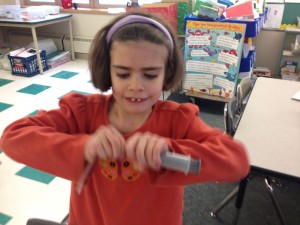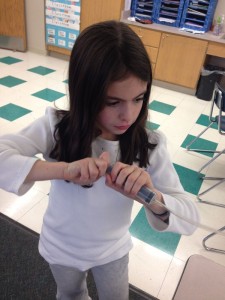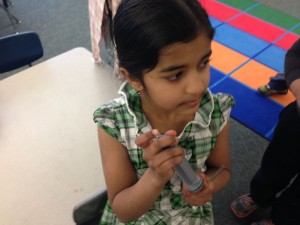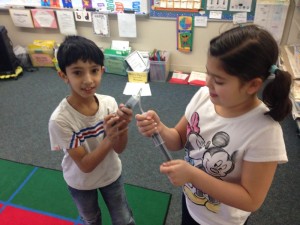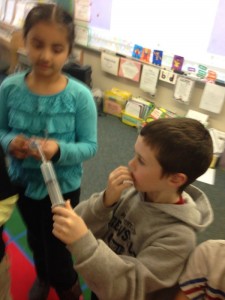Posted by kavery508 | Posted in Uncategorized | Posted on January 12, 2015
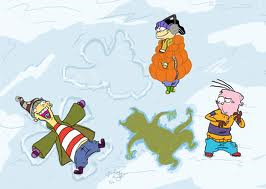 Winter’s here! We’ll be going outside most afternoons for recess still, even when it’s snowing. Please send your child to school with boots when there’s snow, along with hats, gloves, and winter coats.
Winter’s here! We’ll be going outside most afternoons for recess still, even when it’s snowing. Please send your child to school with boots when there’s snow, along with hats, gloves, and winter coats.
 This week’s new comprehension strategy is predicting. Always, the #1 thing we want students to do when they read for meaning is to think about the text. When we do that, we can’t help but make predictions–predictions about where a story is going next; predictions about what language or vocabulary we will likely encounter next; predictions about answers to our questions that arise when we read. Equally important is to check our predictions, or guesses, as we read on, and adjust our thinking accordingly. It’s what helps us learn new things and it makes us engage with text, building our lifelong learning skills. Here’s a short article on predicting with ideas for making connections to science at home: http://www.readingrockets.org/article/making-predictions
This week’s new comprehension strategy is predicting. Always, the #1 thing we want students to do when they read for meaning is to think about the text. When we do that, we can’t help but make predictions–predictions about where a story is going next; predictions about what language or vocabulary we will likely encounter next; predictions about answers to our questions that arise when we read. Equally important is to check our predictions, or guesses, as we read on, and adjust our thinking accordingly. It’s what helps us learn new things and it makes us engage with text, building our lifelong learning skills. Here’s a short article on predicting with ideas for making connections to science at home: http://www.readingrockets.org/article/making-predictions
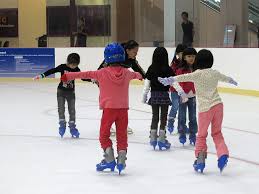 As our narrative writing lessons wrap up for the trimester, students are working on adding description while stretching out their main events (which are all about something that happened over vacation). At first, students were tempted to write a few short actions: I got my sled; I went down the hill; etc. With teacher help, kids are finding they have a wealth of description stored in their head, that can help them stretch out the moment while putting pictures in their readers’ minds: I reached down and pushed against the hard, white snow; I grabbed the small handles of my big, blue tube; I slid over the icy bump; etc. As an assessment, students will be asked to write independently about a time they spent in the gym or outside. We’ll be looking for progress in developing their main events like in the examples above. For more on details in writing, including things you can do at home: https://jr.brainpop.com/writing/poetry/writingwiththesenses/grownups.weml
As our narrative writing lessons wrap up for the trimester, students are working on adding description while stretching out their main events (which are all about something that happened over vacation). At first, students were tempted to write a few short actions: I got my sled; I went down the hill; etc. With teacher help, kids are finding they have a wealth of description stored in their head, that can help them stretch out the moment while putting pictures in their readers’ minds: I reached down and pushed against the hard, white snow; I grabbed the small handles of my big, blue tube; I slid over the icy bump; etc. As an assessment, students will be asked to write independently about a time they spent in the gym or outside. We’ll be looking for progress in developing their main events like in the examples above. For more on details in writing, including things you can do at home: https://jr.brainpop.com/writing/poetry/writingwiththesenses/grownups.weml
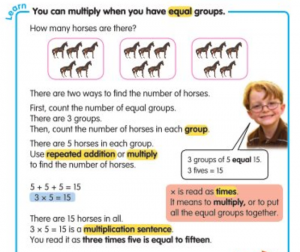 Chapter 5 in math is meant to be an introduction to multiplication and division. Students are expected to be able to use repeated addition of equal groups to solve multiplication and to read and use the shorthand ( __ x __ = ___ ). They should also understand how division means to split a number into equal groups, and be familiar with the shorthand. Our focus this week is on using multiplication and division to make sense of, and solve, real-world problems. Consider this example: a. Charlie made money shoveling snow last weekend. He made 5 dollars on Saturday. He made 3 times as many dollars on Sunday. How many dollars did he make last weekend? Students are encouraged to solve this by drawing equal groups of objects and either adding or multiplying. b. He gave all the money he made to his 5 sisters. Each sister got the same amount. How many did each sister get? Here, students can show it by drawing equal groups (5 circles, e.g.) and distributing the 20 dollars using dots (one for her; one for her;, etc.) or using repeated subtraction (20-4-4-4-4-4=0). We will finish up the chapter and take the tests on it this week.
Chapter 5 in math is meant to be an introduction to multiplication and division. Students are expected to be able to use repeated addition of equal groups to solve multiplication and to read and use the shorthand ( __ x __ = ___ ). They should also understand how division means to split a number into equal groups, and be familiar with the shorthand. Our focus this week is on using multiplication and division to make sense of, and solve, real-world problems. Consider this example: a. Charlie made money shoveling snow last weekend. He made 5 dollars on Saturday. He made 3 times as many dollars on Sunday. How many dollars did he make last weekend? Students are encouraged to solve this by drawing equal groups of objects and either adding or multiplying. b. He gave all the money he made to his 5 sisters. Each sister got the same amount. How many did each sister get? Here, students can show it by drawing equal groups (5 circles, e.g.) and distributing the 20 dollars using dots (one for her; one for her;, etc.) or using repeated subtraction (20-4-4-4-4-4=0). We will finish up the chapter and take the tests on it this week.
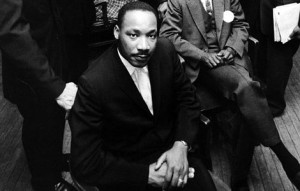 In Social Studies, we have learned to identify character traits of great citizens and leaders (determined; patriotic; etc.). This week, we will analyze the life and achievements of Martin Luther King, Jr. (MLK) and learn to assign character traits to him based on evidence from biographical texts and video. Check out this great video from Brainpop (an awesome and highly engaging resource that I use a lot!) and keep the learning going at home: https://www.brainpop.com/socialstudies/ushistory/martinlutherkingjr/. Then consider these traits: determined; hardworking; patriotic; creative; honest; responsible; brave. Which words best apply to MLK? What is your evidence?
In Social Studies, we have learned to identify character traits of great citizens and leaders (determined; patriotic; etc.). This week, we will analyze the life and achievements of Martin Luther King, Jr. (MLK) and learn to assign character traits to him based on evidence from biographical texts and video. Check out this great video from Brainpop (an awesome and highly engaging resource that I use a lot!) and keep the learning going at home: https://www.brainpop.com/socialstudies/ushistory/martinlutherkingjr/. Then consider these traits: determined; hardworking; patriotic; creative; honest; responsible; brave. Which words best apply to MLK? What is your evidence?
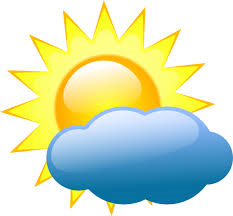 In science, we learned first hand how air can be captured and compressed. This week we will apply that knowledge to create a hydraulic system of tubes and pipes. The big idea is that kids understand that air, wind, and pressure are important in the world around us, and that they affect our weather. To that end, we will learn how clouds form (see the demonstration here: https://www.youtube.com/watch?v=wagrbfKV5bE) We will also learn to identify 3 types of clouds–cirrus, cumulus, and stratus–and use them to observe and predict the weather each day.
In science, we learned first hand how air can be captured and compressed. This week we will apply that knowledge to create a hydraulic system of tubes and pipes. The big idea is that kids understand that air, wind, and pressure are important in the world around us, and that they affect our weather. To that end, we will learn how clouds form (see the demonstration here: https://www.youtube.com/watch?v=wagrbfKV5bE) We will also learn to identify 3 types of clouds–cirrus, cumulus, and stratus–and use them to observe and predict the weather each day.
Ask your child to describe and explain what is happening in these pictures. How do they show air; capturing; compression; push; pull; what happened as a result?

